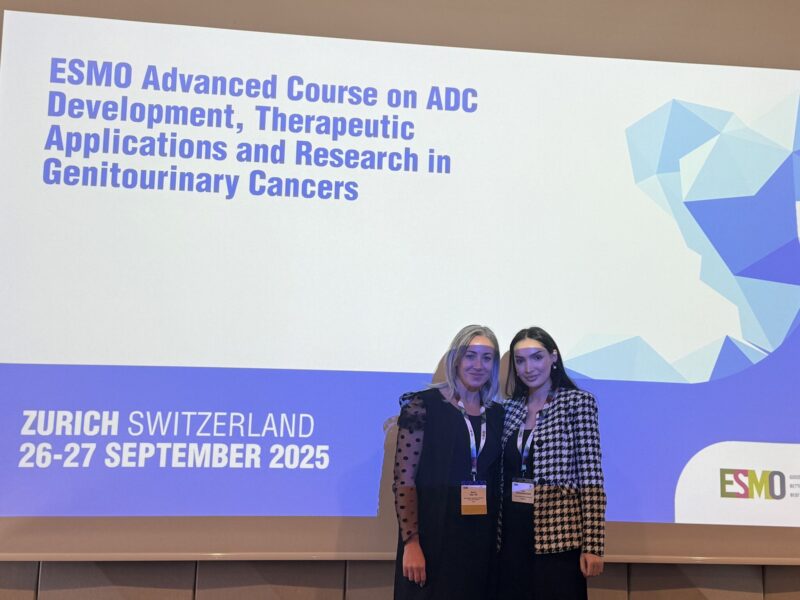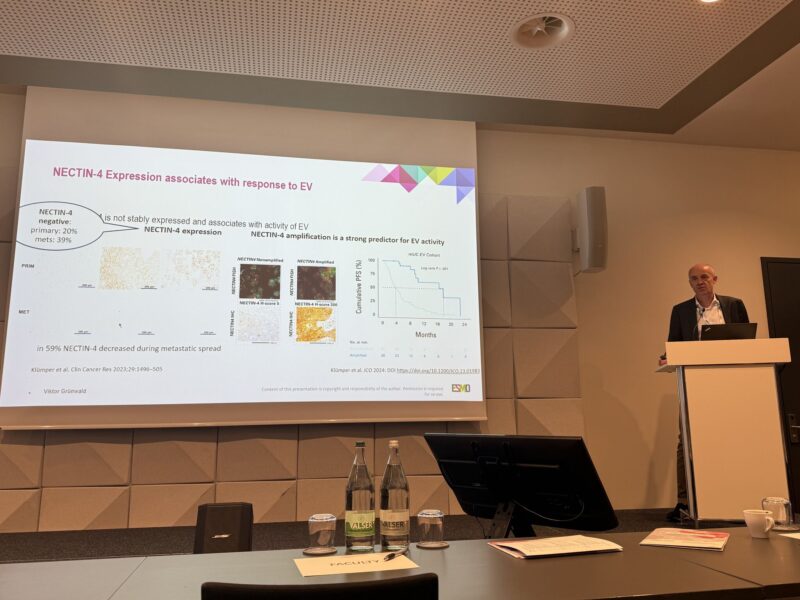The ESMO Advanced Course on ADC Development, Therapeutic Applications, and Research in Thoracic Cancers 2025 was held in Zurich, Switzerland, on September 24–25, 2025. Co-chaired by experts, the course featured an international faculty of leading thoracic oncology and drug development specialists.
It covered the latest advances in antibody-drug conjugates (ADCs), translational research, practical integration of ADCs into clinical care, and future perspectives. The course was highly interactive with lectures, workshops, and discussion seminars, designed for experienced oncologists and specialists. Participants earned 9 ESMO-MORA category 1 CME points.
Nare Hovhannisyan, Publishing Editor at OncoDaily and Oncology Resident at National Center of Oncology of Armenia, shared some posts on LinkedIn about this Conference:
Next Generation ADCs: New Backbones for Precision Drug Delivery
“Dr. Syed Hussain speaks about “Next Generation ADCs: New Backbones for Precision Drug Delivery” at the ESMO – European Society for Medical Oncology Advanced Course on ADC in GU Cancers
Here are the essential takeaways
• Resistance is Complex (MDR): Drug resistance to ADCs is driven by multiple factors, not just low target expression. Mechanisms include target loss, linker issues, and resistance to the chemotherapy payload.
• Key Biomarker: For the Nectin-4 ADC (Enfortumab Vedotin, EV), gene amplification is a better predictor of response and survival benefit than mere target expression.
• Highly Active ADCs: HER2 (T-DXd) and Trop-2 (Sacituzumab Govitecan, SG) are showing significant activity, even in heavily pre-treated patients who failed prior lines.
• Clinical Strategy: Toxicity (especially neutropenia) must be managed well (e.g., using G-CSF). ADCs can be successfully combined with immunotherapy.
• Future Focus: The goal is increased cures. This requires gathering real-world data and mandatory multidisciplinary collaboration (medical oncology, urology, etc.).”

Marzia Del Re session at the ESMO Advanced Course on ADC in Genitourinary Cancers
“Key Takeaways from Dr. Marzia Del Re session at the ESMO – European Society for Medical Oncology Advanced Course on ADC in Genitourinary Cancers.
Mechanisms of resistance vary by tumor biology
• The same drug and same target may show different resistance mechanisms depending on tumor type (e.g. HER2 breast cancer vs. HER2 lung cancer).
• Beyond mutations, resistance can also arise from altered drug transport, intracellular trafficking, or heterogeneous biomarker expression.
Target expression matters, but not just quantity
• It’s not only about “high vs. low” biomarker expression.
• Spatial distribution of target expression within the tumor also impacts response.
Sequencing ADCs is possible
• If resistance is at the antibody target level, switching antibody (keeping payload) may help.
• If resistance is payload-related, maintaining antibody while changing payload can be an option.
Drug development: rethink dose-finding
• For targeted drugs, the most effective dose ≠ maximum tolerated dose.
• The goal is to maintain drug exposure that achieves ≥90% target engagement, considering tumor biology (e.g. vascularization).
Take home message
Resistance to ADCs is multifactorial involving target biology, payload activity, and tumor microenvironment. Understanding these mechanisms is key to optimizing sequencing strategies and guiding next-generation ADC developmen”

Deep Dive into ADC Innovation with Dr. Viktor Grünwald Grünwald
“Fascinating deep dive into ADC innovation with Dr. Viktor Grünwald Grünwald at the ESMO – European Society for Medical Oncology Advanced Course!
His presentation, “Cancer-Targeting Therapeutics: A Platform Approach Beyond Cytotoxic Payloads,” highlighted the critical engineering challenges and the incredible design strategies driving the next wave of Antibody-Drug Conjugates. This isn’t just about the payload anymore, it’s about the platform.
Here are three major takeaways on how ADCs are being reinvented
Overcoming the Penetration Barrier
• The Problem: The Binding Site Barrier (BSB). Large ADCs often bind aggressively to the tumor’s outer layer, failing to penetrate the core. This leaves the center of the tumor untreated.
• The Solution: Designing smaller carrier systems (like bicycle peptides) to improve deep tissue distribution and ensure more homogeneous drug delivery across the entire tumor.
Precision Activation: The Probody Era
• The Future is the Prodrug: Next-generation ADCs are moving toward Probody ADCs. These constructs remain inactive systemically, only releasing their potent payload when a specific enzyme or factor in the tumor microenvironment cleaves its protective shield.
• The Impact: This highly specific activation is the ultimate strategy to reduce off-target toxicity while maximizing efficacy.
Toxicity and Diagnostics
• Toxicity is Structural: The clinical toxicity profile (e.g., peripheral neuropathy) is determined by the entire ADC structure (linker, antibody, drug-to-antibody ratio) not just the type of chemotherapy payload used.
• Better Biomarkers Required: We must move beyond simple IHC. Theranostics (using imaging agents like Nectin-4 tracers) will play a key role in confirming effective drug uptake in vivo before treatment, optimizing patient selection.
The field is evolving rapidly. We are truly entering an era where innovative engineering is redefining the therapeutic index for cancer drugs.”

More Posts Featuring ESMO.
